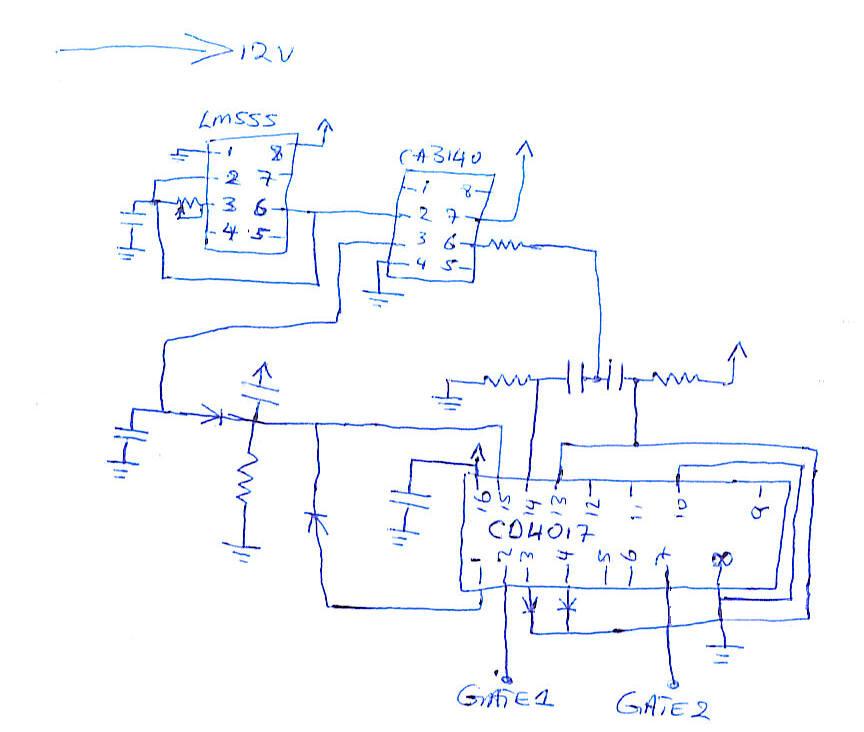| T O P I C R E V I E W |
| kivdenn |
Posted - Feb 19 2009 : 01:55:33 AM
Hey all, I have analysed this circuit http://www.aaroncake.net/forum/uploaded/JUAN%20DELA%20CRUZ/200861173754_LOW%20COST%20500W%20MODIFIED%20SINE%20WAVE%20INVERTER.GIF and realised the the LVD circuit is makin it very user unfriendly as the user has to manualy turn it on when the the LVD is activated and the battery has regained. It is for this reason that I want to eliminate the LVD circuit and replace it with my window voltage comparator that automaticaly off and on and the battery discharges and recharges. I have tried to modify the circuit and this is waht i have come up with , is it ik? Thanks Dennis
Download Attachment:  Oscilator1.jpg Oscilator1.jpg
53.82 KB
 |
| 15 L A T E S T R E P L I E S (Newest First) |
| pebe |
Posted - Mar 04 2010 : 07:18:36 AM
Further calculations give this:
Based on the nominal values given in the TL081 data sheet, if the slider of the 100K pot is set at 61.67K from the diode end, the cut off voltage will be 10.5V and turn on voltage will be 14.46V. |
| pebe |
Posted - Mar 03 2010 : 4:48:25 PM
What is the problem with the circuit resetting at 14V. Isnít that what you wanted Ė no reset button?
With the 100K pot set to the diode side, the circuit will cut out and cut in at 12V.
Now let's try the other extreme. With a single 12V supply, the output of a TL081 will swing between +1.5V and +10.5V. So with the pot set to the end near the 270K, it will cut out at 9.56V and cut back in again at 14.43V. If you set the pot to give a cut out at 10.5V then it will cut back in again at 13.5V. That should be quite acceptable because a battery that has been drained down to 10.5V is not likely to exceed 13.5V when its load is removed. But it will reset when the battery has been charged up again.
It is beyond me how you get it to cut out at 12V but cut in at 14V. I suggest you check over your component values.
|
| kivdenn |
Posted - Mar 03 2010 : 05:12:09 AM
This is the link to the circuit http://www.aaroncake.net/forum/uploaded/kivdenn/20099454131_Full%20undervoltage%20cutout%20circuit.jpg please try to help me with it |
| pebe |
Posted - Mar 01 2010 : 4:15:33 PM
Dennis. You say "...LDV circuit in the diagram below....". You haven't shown a 'circuit below'. There have been several circuits and I haven't time to wade through 7 pages trying to sort out which circuit you mean. Could you please provide a link to the one you are talking about? |
| kivdenn |
Posted - Mar 01 2010 : 11:20:44 AM
Please can some body help me with this. Thanks
Dennnis |
| kivdenn |
Posted - Feb 27 2010 : 04:28:16 AM
quote:
Originally posted by pebe
To apply the LDV to your circuit:-
Remove the 100K resistor and switch from pins2&12 of the CD4025.
Remove the diode from the TL081 of the LDV.
Connect the output of the TL081 to pins2&12 of the CD4025.
Have you discarded the 555 circuit, so you don't need an answer?
Good day to you Mr. Pebe I built your LVD circuit in the diagram bellow but to my suprise when the voltage increases beyond 14VDC it reconects yet our intention was not to reconect until power has been removed and restored from the ICs ie TL081,CD4047, and CD4025. The other problem is that it shuts down at 12V not 10.5V as we had discussed. What can i do to stop these anomalies? Thanks
Dennis |
| kivdenn |
Posted - Oct 26 2009 : 05:24:26 AM
Thanks big brother let me check it out . |
| pebe |
Posted - Oct 25 2009 : 12:28:57 PM
You want know how to use it? Then get a tutorial on the subject.
I Googled for 'tutorial oscilloscopes' and got 75,000 hits. This is just one of them
http://www.hobbyprojects.com/oscilloscope_tutorial.html
If I can do it, then so can you. Don't expect to be spoon-fed all your life - try thinking for yourself. |
| kivdenn |
Posted - Oct 25 2009 : 11:15:31 AM
I got the PC scope but how do I connect my oscilator to the PC, van you help me? I will be posting my Circuit soon. thanks |
| audioguru |
Posted - Oct 24 2009 : 5:46:29 PM
Kivdenn should post whatever schematic he made with the part numbers of its parts.
Then we can see what he is talking about. |
| pebe |
Posted - Oct 24 2009 : 2:29:00 PM
Kivdem, You have an uncanny knack of taking good circuits and failing to make them work.
Check over your assembly. If all seems OK then get a copy of the PC Scope I told you about. Then you can do meaningful measurements and give more details of waveforms and voltages at the pins. That way you will get offered some guidance.
Re 'It has failed'. I cannot fault-find with a blindfold on and I have run out of answers to guesses! |
| kivdenn |
Posted - Oct 24 2009 : 10:13:20 AM
I have connected the two 4.7k resistors across the battery supply and connected pins 6 and 3 to the piont where the two resistors meet i.e half of the supply voltage but It has also failed. Is there any thing we can do about it? Thanks Dennis |
| kivdenn |
Posted - Oct 20 2009 : 11:28:14 AM
Ok let me try it out thanks |
| pebe |
Posted - Oct 20 2009 : 07:08:44 AM
The circuit I gave you a link to will work quite well on a single 12V battery, provided you do the following.
Connect pin 4 to 0V
Connect pin 8 to +12V
Connect two 4.7K resistors in series across the 12V supply
Connect pins 3 & 6 to the junction of the two resistors.
Pins 3 & 6 will then be at half the supply voltage |
| kivdenn |
Posted - Oct 20 2009 : 06:05:40 AM
I can get the 555 but the specific LMC555 are not availabe all I can get is NE555 and these are completly different. LMC555 is a CMOS and NE555 is a bipolar IC. I think that clears the air for you.Do you have an idea any triangular wave oscilator that can be directly connected to the battery and it produces oscilations? Thanks |

